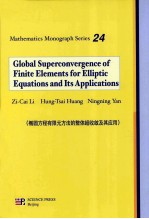

椭圆方程有限元方法的整体超收敛及其应用 英文版PDF电子书下载
- 电子书积分:12 积分如何计算积分?
- 作 者:李子才,黄宏财,严宁宁著
- 出 版 社:北京:科学出版社
- 出版年份:2011
- ISBN:9787030334794
- 页数:324 页
Chapter 1 Basic Approaches 1
1.1 Introduction 1
1.2 Simplified Hybrid Combined Methods 3
1.3 Basic Theorem for Global Superconvergence 6
1.4 Bilinear Elements 8
1.5 Numerical Experiments 12
1.6 Concluding Remarks 15
Chapter 2 Adini's Elements 17
2.1 Introduction 17
2.2 Adini's Elements 19
2.3 Global Superconvergence 22
2.3.1 New error estimates 22
2.3.2 A posteriori interpolant formulas 25
2.4 Proof of Theorem 2.3.1 32
2.4.1 Preliminary lemmas 32
2.4.2 Main proof of Theorem 2.3.1 39
2.5 Stability Analysis 40
2.6 New Stability Analysis via Effective Condition Number 41
2.6.1 Computational formulas 42
2.6.2 Bounds of effective condition number 44
2.7 Numerical Experiments and Concluding Remarks 48
Chapter 3 Biquadratic Lagrange Elements 55
3.1 Introduction 56
3.2 Biquadratic Lagrange Elements 57
3.3 Global Superconvergence 59
3.3.1 New error estimates 59
3.3.2 Proof of Theorem 3.3.1 67
3.3.3 Proof of Theorem 3.3.2 73
3.3.4 Error bounds for Q8 elements 73
3.4 Numerical Experiments and Discussions 74
3.4.1 Global superconvergence 75
3.4.2 Special case of h=k and fxxyy=0 77
3.4.3 Comparisons 78
3.4.4 Relation between uh and ? 80
3.5 Concluding Remarks 83
Chapter 4 Simplified Hybrid Method for Motz's Problems 85
4.1 Introduction 85
4.2 Simplified Hybrid Combined Methods 86
4.3 Lagrange Rectangular Elements 89
4.4 Adini's Elements 96
4.5 Concluding Remarks 99
Chapter 5 Finite Difference Methods for Singularity Problems 101
5.1 Introduction 101
5.2 The Shortley-Weller Difference Approximation 102
5.3 Analysis for uD h with no Error of Divergence Integration 106
5.4 Analysis for uh with Approximation of Divergence Integration 112
5.5 Numerical Verification on Reduced Convergence Rates 120
5.5.1 The model on stripe domains 120
5.5.2 The Richardson extrapolation and the least squares method 124
5.6 Concluding Remarks 128
Chapter 6 Basic Error Estimates for Biharmonic Equations 130
6.1 Introduction 130
6.2 Basic Estimates for ∫∫Ω(u-uI)xxvxxds 136
6.3 Basic Estimates for ∫∫Ω(u-uI)xyvxyds 141
6.4 New Estimates for ∫∫Ω(u-uI)xyvxyds for Uniform Rectangular Elements 147
6.5 New Estimates for ∫∫Ω(u-uI)xxvyyds 152
6.6 Main Theorem of Global Superconvergence 157
6.7 Concluding Remarks 158
Chapter 7 Stability Analysis and Superconvergence of Blending Problems 160
7.1 Introduction 160
7.2 Description of Numerical Methods 162
7.3 Stability Analysis 167
7.3.1 Optimal convergence rates and the uniform VO h-elliptic inequality 167
7.3.2 Bounds of condition number 170
7.3.3 Proof for Theorem 7.3.4 174
7.4 Global Superconvergence 179
7.5 Numerical Experiments and Other Kinds of Superconvergence 184
7.5.1 Verification of the analysis in Section 7.3 and Section 7.4 184
7.5.2 New superconvergence of average nodal solutions 188
7.5.3 Superconvergence of L∞-norm 189
7.5.4 Global superconvergence of the a posteriori interpolant solutions 190
7.6 Concluding Remarks 190
Chapter 8 Blending Problems in 3D with Periodical Boundary Conditions 192
8.1 Introduction 192
8.2 Biharmonic Equations 194
8.2.1 Description of numerical methods 194
8.2.2 Global superconvergence 197
8.3 The BPH-FEM for Blending Surfaces 201
8.4 Optimal Convergence and Numerical Stability 206
8.5 Superconvergence 207
Chapter 9 Lower Bounds of Leading Eigenvalues 212
9.1 Introduction 212
9.1.1 Bilinear element Q1 213
9.1.2 Rotated Q1 element(Qrot 1) 213
9.1.3 Extension of rotated Q1 element(EQrot 1) 214
9.1.4 Wilson's element 214
9.2 Basic Theorems 216
9.3 Bilinear Elements 219
9.4 Qrot 1 and EQrot 1 Elements 221
9.4.1 Proof of Lemma 9.4.1 225
9.4.2 Proof of Lemma 9.4.2 226
9.4.3 Proof of Lemma 9.4.3 227
9.4.4 Proof of Lemma 9.4.4 230
9.5 Wilson's Element 232
9.5.1 Proof of Lemma 9.5.1 234
9.5.2 Proof of Lemma 9.5.2 237
9.5.3 Proof of Lemma 9.5.3 and Lemma 9.5.4 238
9.6 Expansions for Eigenfunctions 239
9.7 Numerical Experiments 241
9.7.1 Function ρ=1 242
9.7.2 Function ρ≠0 248
9.7.3 Numerical conclusions 251
Chapter 10 Eigenvalue Problems with Periodical Boundary Conditions 253
10.1 Introduction 253
10.2 Periodic Boundary Conditions 256
10 3 Adini's Elements for Eigenvalue Problems 258
10 4 Error Analysis for Poisson's Equation 260
10.5 Superconvergence for Eigenvalue Problems 263
10.6 Applications to Other Kinds of FEMs 265
10.6.1 Bi-quadratic Lagrange elements 265
10.6.2 Triangular elements 266
10.7 Numerical Results 267
10.8 Concluding Remarks 273
Chapter 11 Semilinear Problems 274
11.1 Introduction 274
11.2 Parameter-Dependent Semilinear Problems 276
11.3 Basic Theorems for Superconvergence of FEMs 279
11.4 Superconvergence of Bi-p(≥2)-Lagrange Elements 286
11.5 A Continuation Algorithm Using Adini's Elements 294
11.6 Conclusions 296
Chapter 12 Epilogue 297
12.1 Basic Framework of Global Superconvergence 297
12.2 Some Results on Integral Identity Analysis 300
12.3 Some Results on Global Superconvergence 302
Bibliography 306
Index 320
- 《Helmholtz方程的步进计算方法研究》李鹏著 2019
- 《ANSYS有限元基础教程》王新荣主编 2019
- 《数学物理方程与特殊函数》于涛,杨延冰编 2019
- 《二十面体和5次方程的解的讲义》(德)菲利克斯·克莱因著 2019
- 《椭圆函数相关凝聚态物理模型与图表示》石康杰,杨文力,李广良编者;刘凤娟责编 2019
- 《方程组实数解的几何方法 影印版》Frank Sottile 2018
- 《大数据时代应用语言学研究中的结构方程建模》王天剑,王彦之 2019
- 《UG NX 12.0中文版动力学与有限元分析自学手册》胡爱闽龙铭 2019
- 《微分求积升阶谱有限元方法=DIFFERENTIAL QUADRATURE HIERARCHICAL FINITE ELEMENT METHOD》刘波 2019
- 《Cauchy函数方程》刘培杰数学工作室编著 2017
- 《肿瘤患者的中医饮食疗法》胡家才,胡钦勇主编 2018
- 《兰蕙镜》(清)屠用宁著 2018
- 《投资者的敌人》朱宁著 2020
- 《路过星空遇见你》秦宁著 2017
- 《全国大学生英语竞赛A类(研究生)应试指南 第4版》圣才学习网主编 2019
- 《北方狩猎》魏市宁著 2019
- 《马克思共同体思想的哲学研究》徐宁著 2020
- 《朱玉贤《现代分子生物学》笔记和课后习题(含考研真题)详解 第5版》圣才考研网主编 2019
- 《电子垃圾污染土壤修复》卢桂宁著 2019
- 《投资者的朋友》朱宁著 2020
- 《指向核心素养 北京十一学校名师教学设计 英语 七年级 上 配人教版》周志英总主编 2019
- 《《走近科学》精选丛书 中国UFO悬案调查》郭之文 2019
- 《北京生态环境保护》《北京环境保护丛书》编委会编著 2018
- 《中医骨伤科学》赵文海,张俐,温建民著 2017
- 《美国小学分级阅读 二级D 地球科学&物质科学》本书编委会 2016
- 《指向核心素养 北京十一学校名师教学设计 英语 九年级 上 配人教版》周志英总主编 2019
- 《强磁场下的基础科学问题》中国科学院编 2020
- 《小牛顿科学故事馆 进化论的故事》小牛顿科学教育公司编辑团队 2018
- 《小牛顿科学故事馆 医学的故事》小牛顿科学教育公司编辑团队 2018
- 《高等院校旅游专业系列教材 旅游企业岗位培训系列教材 新编北京导游英语》杨昆,鄢莉,谭明华 2019
